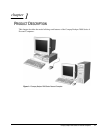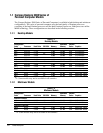
1-6 Product Description
1.3.2 System Board
The desktop and minitower models of the Compaq Deskpro 2000 Series of Personal Computers have
a single system board configuration. The Pentium system board uses an Intel Pentium processor. The
Pentium II system board uses the Intel Pentium II processor. The processors are designed using
MMX technology. The desktop units of both systems have the I/O panel mounted to the system board
and is spared with the I/O panel. On the minitower, the system board is attached to a sliding tray and
is spared with the tray.
1.3.3 Processor
The Pentium system boards run at processor speeds of 166 MHz, 200 MHz, or 233 MHz depending on
the model. A computer with a processor speed of 166 MHz can be upgraded to a processor speed of
either 200 MHz or 233 MHz. A computer with processor speed 200 MHz can be upgraded to a
processor speed of 233 MHz.
The Pentium II system boards run at speeds of 233 MHz, 266 MHz, or 300 MHz. A Pentium II system
with a processor speed of 233 MHz can be upgraded to a processor speed of either 266 MHz or 300
MHz, and a Pentium II system with a processor speed 266 MHz can be upgraded to a processor speed
of 300 MHz.
Utilizing MMX technology in the design of the processors enhances the systems’ ability to take
advantage of the MMX instructions while preserving compatibility with existing software and
operating systems
1.3.4 System Memory
The system supports base (conventional) and extended memory. Operating systems such as MS-DOS,
OS/2, UNIX, and all application programs use base memory. For better performance, Windows NT,
OS/2, and UNIX, as well as many MS-DOS applications, use extended memory.
For proper system operation, the DIMMs must be industry standard 168-pin, 66-MHz or faster
unbuffered SDRAM DIMMs. The memory modules may also be unbuffered extended data out (EDO)
DIMMs. SDRAM DIMMs must support CAS Latency 2 or 3 (CL = 2 or CL = 3) with a data access
time (clock to data out) of 9.0 ns or less. The DIMMs must also contain Joint Electron Device
Engineering Council (JEDEC) Serial Presence Detect (SPD) information. SDRAMS on DIMMs must
have a data width of x8, x16, or x32; x4 is not supported. The system will not start using unsupported
DIMMs or incompatible DIMM configurations. See Appendix H, “Intel 440LX Chipset Memory
limitations,” for incompatible and unsupported DIMM configurations. Refer to Chapters 5 and 6,
“Removal and Replacement Procedures,” for information on how to upgrade system memory.
1.3.5 Cache Memory
Cache memory is very fast memory used for temporarily storing data for fast access by the processor.
The faster the processor, the more need there is for faster temporary data storage. A 256 KB write-
through, direct-mapped secondary (L2) cache is integrated onto the system board on all Pentium
models. The L2 cache memory for the Pentium models may be increased to 512 KB with the addition
of an optional plug-in module on the system board.


















